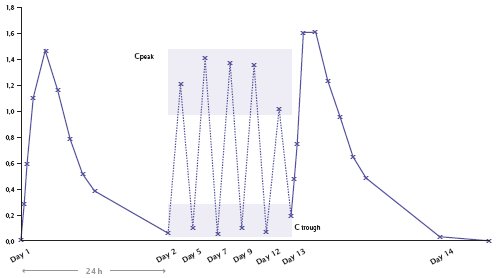Pharmacokinetics of Vidalta®
Sustained-release for once daily dosing
In the figure below the sustained-release formulation of Vidalta® is compared with a conventional carbimazole tablet:
- Peak concentrations are reached 3-4 hours after Vidalta 10 mg administration and 5-7 hours after Vidalta 15 mg administration.
- Peak plasma concentrations of thiamazole are less pronounced than for conventional tablet formulations.
- Thiamazole persists in the circulation for at least 20 hours adter Vidalta 10 mg and for at least 24 hours after Vidalta 15 mg.

Absence of accumulation on repeated dosing
Repeated dosing of Vidalta® does not result in accumulation of thiamazole in the plasma.

Reversible action
Thiamazole, the active metabolite of carbimazole, inhibits thyroid hormone production and therefore cessation of treatment with carbimazole will result in a rapid (within 48 hours) return to pre-treatment thyroid hormone levels. Chronic administration is therefore necessary unless surgical or radiation-induced thyroidectomy is performed.
Rapid absorption
The carbimazole in Vidalta® is rapidly absorbed from the gastrointestinal tract after oral administration and hydrolysed in the gastrointestinal tract (or immediately after entering into the circulation) to the active metabolite converted to thiamazole. The absolute bioavailability of thiamazole from carbimazole in Vidalta 15 mg tablets is 88%.
Administration of Vidalta® at or around feeding
The presence of food in the gastrointestinal tract at the time of administration has been shown to increase the bioavailability of thiamazole. When tablets are administered with food, both Cmax and AUC last may be increased whereas tmax is not expected to change.
The presence of food in the gastrointestinal tract of the cat at time of treatment increases the bioavailability of thiamazole
- increased total amount of thiamazole in body
- unchanged time to Cmax (tmax)

Comparison of thiamazole absorption in fed and fasted cats
Absorption is 40% higher in fed cats than in fasted cats (Frenais and others 2008). Dosing of cats in a fed or fasted state should be kept consistent.

